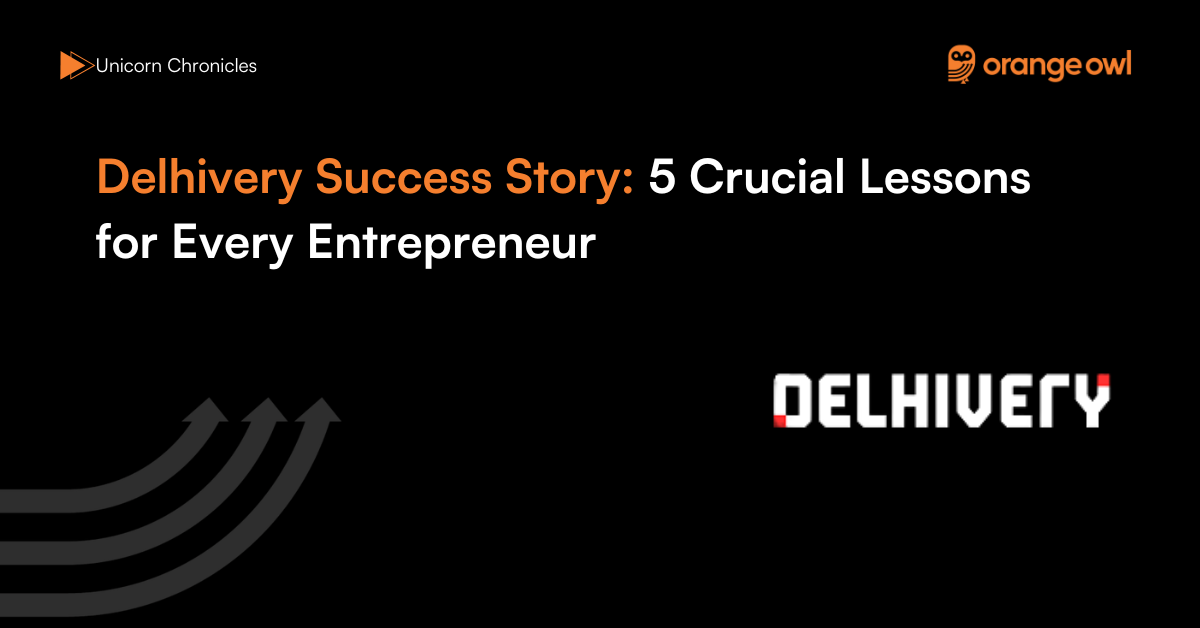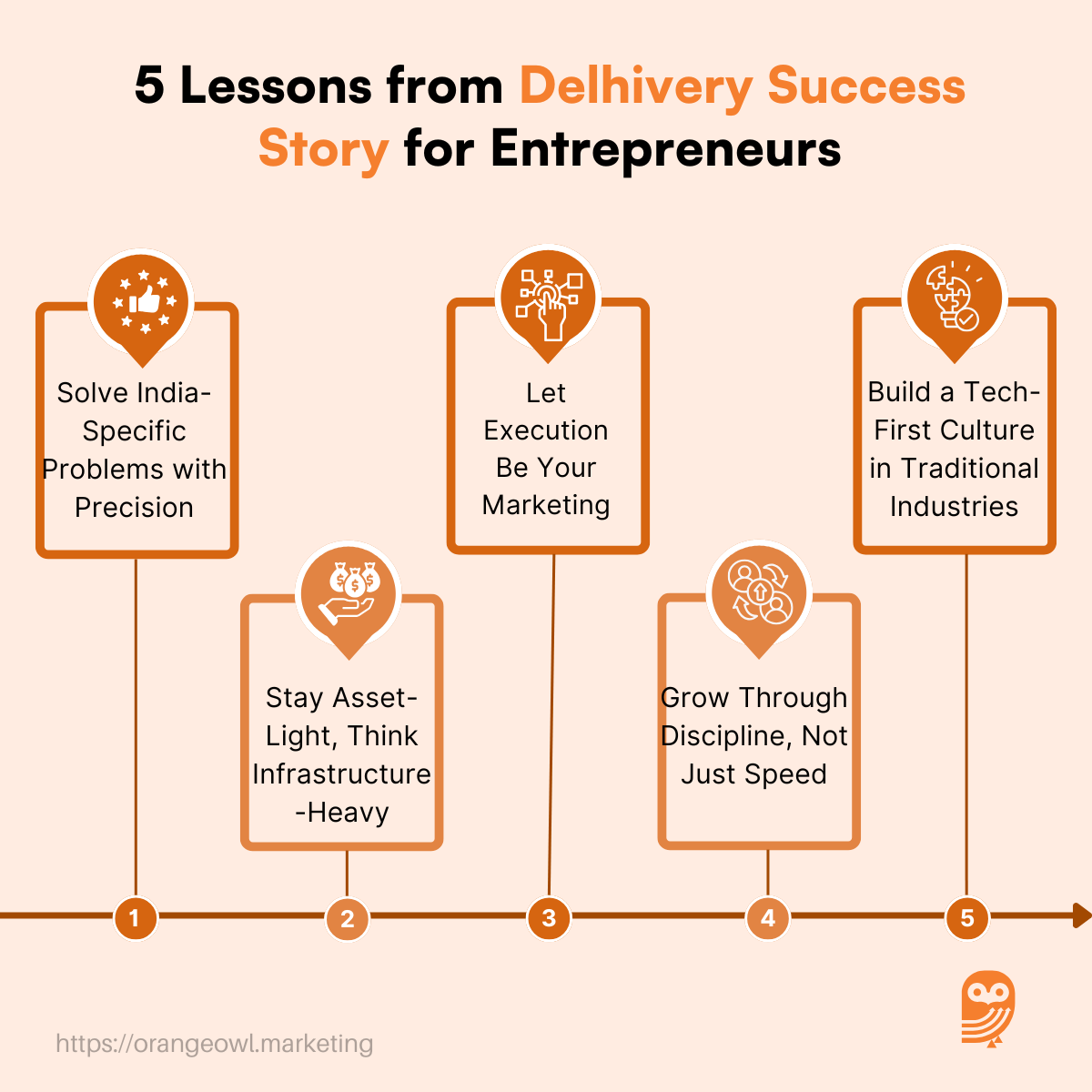Delhivery Success Story: 5 Crucial Lessons for Every Entrepreneur
Vivek Goel
June 17, 2025

Table of Contents
Introduction
Founded in 2011 by Sahil Barua, Kapil Bharati, Mohit Tandon, Suraj Saharan, and Bhavesh Manglani, Delhivery began as a bold vision to transform India’s fragmented logistics landscape. Starting with a small team and limited resources in Gurugram, the founders tackled the massive challenge of building a reliable, tech-driven supply chain infrastructure to serve India’s booming e-commerce market. From coding their systems to personally managing operations on the ground, their hands-on approach laid a strong foundation for what would become one of India’s leading logistics unicorns.
The Delhivery success story is rooted in solving critical pain points faced by businesses and consumers—unreliable deliveries, lack of transparency, and inefficient warehousing. They pioneered innovative solutions such as real-time tracking, integrated warehousing, and last-mile delivery services tailored to India’s unique challenges. These efforts not only accelerated their growth but also helped modernise the entire logistics ecosystem in India.
Over time, Delhivery expanded beyond parcel delivery into a comprehensive logistics platform offering warehousing, fulfilment, cross-border shipping, and reverse logistics. Their deep focus on technology, scalability, and customer-centricity has enabled them to serve thousands of businesses across diverse sectors.
In the words of co-founder Sahil Barua: “Logistics is the backbone of commerce, and we are committed to building the infrastructure that enables businesses and customers to connect seamlessly.”
Today, the Delhivery success story stands not only as a market leader but also as a testament to the power of vision, technology, and execution in building India’s future economy.
Origin Story
Delhivery’s journey began in 2011, when Sahil Barua, a Bain & Company consultant, teamed up with four close friends—Kapil Bharati, Mohit Tandon, Suraj Saharan, and Bhavesh Manglani—to take on one of India’s most complex challenges: logistics. At the time, India’s supply chain was broken—disconnected networks, manual operations, and a lack of tech-enabled infrastructure made it difficult for businesses, especially e-commerce platforms, to serve customers reliably.
What sparked Delhivery wasn’t a grand startup pitch, but a simple realisation: local restaurants in Gurugram were struggling to deliver orders on time. Originally conceptualised as a hyperlocal delivery service for food, the idea quickly evolved when the founders saw a much larger, systemic problem: India lacked a unified, technology-first logistics network that could support the future of commerce.
Working out of a small office in Gurugram, the Delhivery team began with just 10 delivery boys and a few local clients. But their ambitions were anything but small. They built their routing algorithms, optimised delivery timelines, and took a customer-obsessed approach to operations, frequently hitting the road themselves to understand real bottlenecks.
As co-founder Sahil Barua once recalled: “We didn’t just want to build a logistics company. We wanted to build the rails on which Indian commerce could run.”
That vision reshaped Delhivery’s strategy. By 2012, they had pivoted to a full-stack logistics platform, expanding into parcel delivery, warehousing, and fulfilment services—laying the foundation for India’s first truly integrated 3PL (third-party logistics) company.
Their approach wasn’t about mimicking Western logistics models. Instead, they asked,
“What would logistics look like if it were built for India, from scratch?”
The answer: a tech-driven, data-rich, modular network that could serve everyone, from D2C startups to large-scale enterprises, across cities and rural regions alike.
Delhivery’s origin story is not just about fixing what was broken, but about reimagining what logistics could be in a country as vast and varied as India. And that early spirit of hustle, adaptation, and long-term vision continues to define their journey today.
Business Landscape and Challenges
As Delhivery began expanding its footprint, it entered one of the most fragmented and under-digitised sectors in India—logistics and supply chain management. This was a space riddled with inefficiencies: inconsistent service levels, outdated infrastructure, lack of visibility in shipment tracking, and a complete absence of real-time data. The challenge wasn’t just scaling operations—it was about rebuilding the backbone of Indian commerce from the ground up.
Delhivery positioned itself at the intersection of technology and logistics, aiming to disrupt the traditional courier and freight industries through data science, machine learning, and platform-driven solutions. But the early journey was anything but smooth.
The company had to tackle three fundamental barriers:
- Unstructured delivery networks spread across thousands of PIN codes
- A deeply manual supply chain ecosystem resistant to change
- The scepticism of large e-commerce clients, who were wary of trusting a fledgling startup with critical delivery infrastructure
As e-commerce in India began to boom, the pressure to perform mounted. Clients expected scale, speed, and service quality—without compromise. Delhivery’s early days saw them constantly fighting fires, from managing failed deliveries and hiring reliable personnel to integrating new technology on the fly.
In the words of co-founder Kapil Bharati: “We were not just building a logistics company—we were building technology for logistics in a country that had never seen it before.”
Despite these challenges, Delhivery kept iterating. It developed proprietary logistics software, built a distributed warehousing model, and introduced predictive analytics for route optimisation. Their vision was clear:
“Every package should move with precision and predictability—whether it’s going to a metro or a remote village,” said co-founder Suraj Saharan.
By staying nimble and customer-obsessed, Delhivery gradually earned the trust of India’s top e-commerce companies, turning early headwinds into learning opportunities. These formative years laid the groundwork for what would eventually become India’s most advanced third-party logistics network, capable of serving over 18,000 pin codes with a workforce of more than 24,000 employees.
Growth Strategies
Delhivery’s rise as India’s premier logistics and supply chain powerhouse can be attributed to a set of sharp, tech-led, and customer-centric strategies that prioritised scale, efficiency, and adaptability in an industry long dominated by fragmentation and legacy systems.
A cornerstone of Delhivery’s growth playbook was its platform-first approach. Rather than operate merely as a courier service, Delhivery built an integrated logistics operating system that allowed businesses—large and small—to plug into a suite of services spanning parcel transportation, warehousing, freight, cross-border logistics, and supply chain software. This full-stack offering made Delhivery indispensable to India’s rapidly expanding digital commerce ecosystem.
To ensure scale without losing precision, Delhivery focused heavily on automation and data science. Its supply chain was reimagined using machine learning models for demand forecasting, dynamic route planning, and real-time shipment visibility. These investments transformed what was once an analogue process into a data-driven logistics engine, capable of serving over 18,000 pin codes with consistently high service levels.
The company also made several strategic acquisitions and partnerships to accelerate vertical integration. From warehousing solutions to cross-border logistics and freight forwarding, Delhivery steadily expanded its portfolio through both organic growth and M&A, including its acquisition of Spoton Logistics and partnerships with global giants like FedEx. This not only enhanced operational capabilities but also diversified revenue streams beyond last-mile delivery.
Another key enabler of Delhivery’s success was its infrastructure-light, technology-heavy model. While it invested in critical infrastructure, like mega gateways and sort centres, it ensured flexibility by collaborating with third-party partners for ground operations. This hybrid asset model gave Delhivery the ability to scale rapidly while keeping capital expenditure under control.
Internally, Delhivery cultivated a culture of first-principle thinking and operational rigour. Teams were encouraged to challenge traditional norms and find smarter, tech-enabled ways to optimise logistics at every touchpoint. In the words of co-founder Sahil Barua:
“We were not interested in being just another logistics company. We wanted to rewire the supply chain DNA of India.”
These combined strategies didn’t just make Delhivery a logistics leader—they redefined what modern, intelligent logistics could look like in an emerging economy. With a public listing, over $1.25 billion in funding, and strong backing from global investors like Fidelity, SoftBank, and Nexus Ventures, Delhivery today stands as a testament to how technology, scale, and execution excellence can transform even the most traditional industries.
Marketing Strategy
Unlike consumer-facing brands, Delhivery’s marketing strategy wasn’t built around mass visibility or celebrity endorsements—it was crafted around trust, performance, and partnerships. As a B2B logistics platform, Delhivery focused on building credibility and reliability among its core audiences: e-commerce companies, enterprises, SMEs, and D2C brands. And it did so not with noise, but with clarity, consistency, and proof of execution.
From the outset, Delhivery let its operational excellence do the talking. Fast turnarounds, scalable integrations, and transparent delivery timelines became its most persuasive marketing tools. The brand earned trust not through ads, but through measurable outcomes—reliable first-attempt delivery rates, deep serviceable pin code coverage, and real-time tracking dashboards that clients could depend on.
However, Delhivery wasn’t silent. It built a strong thought leadership presence by engaging in logistics-focused conferences, whitepapers, and tech events, positioning itself as a forward-thinking, tech-first logistics company. Its branding was subtle but consistent: a clean, minimal visual identity and messaging that focused on speed, scale, and intelligence.
A key differentiator was Delhivery’s content-driven storytelling, especially post-IPO. Through LinkedIn, industry blogs, and investor communications, the company spotlighted its innovations, infrastructure capabilities, and client success stories—often featuring detailed visuals of mega fulfilment centres, automation systems, and AI-driven optimisation engines. This reinforced the narrative of Delhivery as not just a logistics company, but a next-generation supply chain enabler.
Regionally, Delhivery also adapted to the needs of small and mid-sized sellers in Tier 2 and Tier 3 cities by launching self-serve onboarding tools, vernacular support, and simple explainer content tailored for non-English-speaking business owners. These initiatives quietly but effectively expanded its client base beyond large e-commerce players to include India’s vast base of SMBs and D2C brands.
As co-founder Sahil Barua put it: “Our goal is to be invisible in the best way possible—seamlessly enabling commerce without getting in the way of it.”
By staying authentic to its B2B mission and using performance, product, and presence as its marketing levers, Delhivery managed to build not just brand recall but deep-rooted brand respect in one of the most demanding sectors of the Indian economy.
5 Crucial Lessons for Every Entrepreneur
1. Solve India-Specific Problems with Precision
Delhivery’s rise wasn’t built on copying global logistics models—it came from solving deeply India-specific challenges. Fragmented roads, unpredictable addresses, low-tech seller ecosystems, and huge geographical diversity required ground-up innovation.
Instead of resisting complexity, Delhivery embraced it—developing AI-led address parsing, pin-code level intelligence, and hyper-local delivery solutions.
Lesson for entrepreneurs: Great businesses in India are built by deeply understanding and engineering for local realities, not importing Western templates.
2. Stay Asset-Light, Think Infrastructure-Heavy
Delhivery adopted a hybrid model—lean on owning trucks, but heavy on building proprietary tech and sorting infrastructure. This gave it both scalability and control, allowing the company to scale fast without being weighed down by capital expenses.
By investing in automation, data science, and warehouse intelligence, it created a backbone for Indian logistics that could handle both volume and complexity.
The takeaway: You don’t need to own everything—own what matters strategically, and outsource the rest smartly.

3. Let Execution Be Your Marketing
Unlike flashier startups, Delhivery rarely chased the limelight. Its reputation was built through performance, consistency, and reliability.
Clients trusted Delhivery not because of celebrity endorsements, but because it delivered, on time, at scale, across the country—even in flood zones and remote villages.
As co-founder Sahil Barua noted: “Our strongest marketing has always been our execution.”
Lesson: In B2B and operations-heavy spaces, reputation is built quietly, one delivery at a time.
4. Grow Through Discipline, Not Just Speed
While many startups equate growth with hyper-speed, Delhivery took a more disciplined approach—scaling in phases, testing rigorously, and keeping capital efficiency in mind. Even when flush with funding, the company made data-driven expansions, whether entering new verticals (like B2B express) or regions.
Lesson for founders: Speed is sexy, but sustainable growth demands patience, clarity, and operational maturity.
5. Build a Tech-First Culture in Traditional Industries
Delhivery showed that even in a legacy-heavy space like logistics, a tech-first mindset can disrupt the status quo.
From its early days, Delhivery hired engineers, data scientists, and product thinkers who could redesign the supply chain with algorithms, APIs, and predictive analytics.
Its tech wasn’t just cosmetic—it was core to everything from routing parcels to forecasting demand.
Entrepreneurial insight: Don’t let the “old-school” nature of your industry fool you. A strong tech DNA can be your sharpest competitive edge—even in dusty warehouses.
Conclusion
Delhivery’s journey from a small team managing e-commerce deliveries in Gurgaon to becoming one of India’s largest logistics tech unicorns is a powerful testament to executional excellence, relentless innovation, and mission clarity. It’s not merely the story of building a logistics company—it’s the story of redefining what logistics can mean in a country as vast and varied as India.
Through deep tech integration, a customer-first mindset, and disciplined scaling, Delhivery has built more than infrastructure—it has built trust. In a space notorious for inefficiencies, Delhivery proved that consistency, data, and grit could unlock massive value.
As co-founder Sahil Barua once said: “Our goal was never just to deliver packages—it was to enable commerce through intelligent logistics.”
For entrepreneurs, the Delhivery success story offers a clear takeaway: solving hard, unsexy problems with precision and patience can often lead to the most enduring businesses. When you marry operational depth with a vision for transformation, the result is not just scale—it’s impact.


